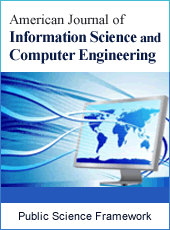American Journal of Information Science and Computer Engineering
Articles Information
American Journal of Information Science and Computer Engineering, Vol.7, No.2, Jun. 2021, Pub. Date: Jul. 26, 2021
Classification of Cerebral Hemorrhage Based on CT Image Segmentation
Pages: 31-35 Views: 1362 Downloads: 185
[01]
Lei Peng, College of Medical Information Engineering, Shandong First Medical University & Shandong Academy of Medical Sciences, Taian, China.
[02]
Yanli Xiao, College of Marxism, Shandong First Medical University & Shandong Academy of Medical Sciences, Taian, China.
[03]
Yufei Zhang, College of Medical Information Engineering, Shandong First Medical University & Shandong Academy of Medical Sciences, Taian, China.
Cerebral hemorrhage is a common cerebrovascular disease. It has the characteristics of high incidence rate, fast onset and high mortality. Therefore, it is of great significance to strengthen the timely and effective treatment of cerebral hemorrhage. Because CT technology is safe, fast, low cost and high efficiency, CT image has always been an important means for doctors to diagnose cerebral hemorrhage. However, it is difficult for doctors to calculate the amount of bleeding, because of the characteristics of brain CT images, such as large noise, uneven gray distribution and fuzzy boundary of hematoma area. Therefore, an automatic cerebral hemorrhage diagnosis method combining active contour segmentation model and random forest classification model is proposed to replace the traditional manual hematoma segmentation method to calculate the hemorrhage volume. Firstly, the hematoma area in CT image is accurately segmented by CV active contour model. Secondly, according to the number and thickness of CT image sequence, the volume of hemorrhage was calculated. Finally, the random forest algorithm is used for classification to assist diagnosis and treatment. The experimental results on the test set show that the proposed algorithm can achieve 95.33% accuracy. It has positive significance in the further classification and follow-up targeted treatment of cerebral hemorrhage.
Cerebral Hemorrhage, Image Segmentation, Active Contour Model, Random Forest Algorithm
[01]
Tiago, Gregório, Sara, et al. Original Intracerebral Hemorrhage Score for the Prediction of Short-Term Mortality in Cerebral Hemorrhage: Systematic Review and Meta-Analysis. [J]. Critical Care Medicine, 2019, 47 (6): 857-864.
[02]
Jieqiong AN, Hao LI, Sun M, et al. Clinical Analysis of Acupuncture Combined with Nimodipine in the Treatment of Acute Cerebral Hemorrhage [J]. World Chinese Medicine, 2020, 15 (06): 892-895+900.
[03]
Vaidyanathan S, Soni B M, Hughes P L, et al. Fatal Cerebral Hemorrhage in a Tetraplegic Patient Due to Autonomic Dysreflexia Triggered by Delay in Emptying Urinary Bladder after Unsuccessful Intermittent Catheterization by Carer: Lessons Learned [J]. International Medical Case Reports Journal, 2018, 11: 53-58.
[04]
Li J, Cheng S Y, Xiong X Y, et al. Clinical Significances and Features of Prompt Brain CT Scan after Intracranial Artery Stenting: Analysis of 501 Cases [J]. Oncotarget, 2017, 8 (69): 114259-114267.
[05]
Li P, Shi T, Y Zhao, et al. Design of Threshold Segmentation Method for Quantum Image [J]. International Journal of Theoretical Physics, 2020, 59 (2): 514-538.
[06]
Mousavi M, Shariaty F, Orooji M, et al. The Performance of Active-Contour and Region Growing Methods Against Noises in the Segmentation of Computed-Tomography Scans [C]// International Youth Conference on Electronics, Telecommunications and Information Technologies (YETI-2020). 2020.
[07]
Ahmed, M, Anter, et al. CT Liver Tumor Segmentation Hybrid Approach using Neutrosophic Sets, Fast Fuzzy C-means and Adaptive Watershed Algorithm – ScienceDirect [J]. Artificial Intelligence in Medicine, 2019, 97 (C): 105-117.
[08]
Chan T F, Vese L A. Active Contours Without Edges [J]. IEEE Transactions on Image Processing, 2001, 10 (2): 266-277.
[09]
Chen H, Yu X S, Wu C D, et al. Fast Image Segmentation Algorithm Based on Parametric Level Set Active Contour Model [J]. Dongbei Daxue Xuebao/Journal of Northeastern University, 2019, 40 (1): 6-10.
[10]
Ma D, Liao Q, Chen Z, et al. Adaptive Local-fitting-based Active Contour Model for Medical Image Segmentation [J]. Signal Processing: Image Communication, 2019, 76: 201-213.
[11]
Hsu W Y, Lu C C, Hsu Y Y. Improving Segmentation Accuracy of CT Kidney Cancer Images using Adaptive Active Contour Model [J]. Medicine, 2020, 99 (47): e23083.
[12]
Chawla N V, Bowyer K W, Hall L O, et al. SMOTE: Synthetic Minority Over-sampling Technique [J]. Journal of Artificial Intelligence Research, 2002, 16 (1): 321-357.
[13]
Xu Z, Shen D, Nie T, et al. An Oversampling Algorithm Combining SMOTE and K-means for Imbalanced Medical Data [J]. Information Sciences, 2021, (572): 574-589.
[14]
Svetnik V, Liaw A, Tong C, et al. Random Forest: a Classification and Regression Tool for Compound Classification and QSAR Modeling [J]. Journal of Chemical Information and Computer Sciences, 2003, 43 (6): 1947-1958.
[15]
Zaaboub N, Douik A. Early Diagnosis of Diabetic Retinopathy using Random Forest Algorithm [C]// 2020 5th International Conference on Advanced Technologies for Signal and Image Processing (ATSIP). 2020.

ISSN Print: 2381-7488
ISSN Online: 2381-7496
Current Issue:
Vol. 7, Issue 3, September Submit a Manuscript Join Editorial Board Join Reviewer Team
ISSN Online: 2381-7496
Current Issue:
Vol. 7, Issue 3, September Submit a Manuscript Join Editorial Board Join Reviewer Team
| About This Journal |
| All Issues |
| Open Access |
| Indexing |
| Payment Information |
| Author Guidelines |
| Review Process |
| Publication Ethics |
| Editorial Board |
| Peer Reviewers |


